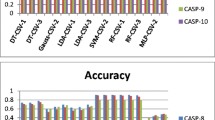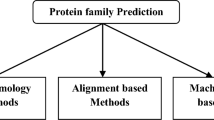Abstract
Lipocalins are functionally diverse proteins that are composed of 120–180 amino acid residues. Members of this family have several important biological functions including ligand transport, cryptic coloration, sensory transduction, endonuclease activity, stress response activity in plants, odorant binding, prostaglandin biosynthesis, cellular homeostasis regulation, immunity, immunotherapy and so on. Identification of lipocalins from protein sequence is more challenging due to the poor sequence identity which often falls below the twilight zone. So far, no specific method has been reported to identify lipocalins from primary sequence. In this paper, we report a support vector machine (SVM) approach to predict lipocalins from protein sequence using sequence-derived properties. LipoPred was trained using a dataset consisting of 325 lipocalin proteins and 325 non-lipocalin proteins, and evaluated by an independent set of 140 lipocalin proteins and 21,447 non-lipocalin proteins. LipoPred achieved 88.61% accuracy with 89.26% sensitivity, 85.27% specificity and 0.74 Matthew’s correlation coefficient (MCC). When applied on the test dataset, LipoPred achieved 84.25% accuracy with 88.57% sensitivity, 84.22% specificity and MCC of 0.16. LipoPred achieved better performance rate when compared with PSI-BLAST, HMM and SVM-Prot methods. Out of 218 lipocalins, LipoPred correctly predicted 194 proteins including 39 lipocalins that are non-homologous to any protein in the SWISSPROT database. This result shows that LipoPred is potentially useful for predicting the lipocalin proteins that have no sequence homologs in the sequence databases. Further, successful prediction of nine hypothetical lipocalin proteins and five new members of lipocalin family prove that LipoPred can be efficiently used to identify and annotate the new lipocalin proteins from sequence databases. The LipoPred software and dataset are available at http://www3.ntu.edu.sg/home/EPNSugan/index_files/lipopred.htm.
Similar content being viewed by others
References
Adam B, Charloteaux B, Beaufays J, Vanhamme L, Godfroid E, Brasseur R, Lins L (2008) Distantly related lipocalins share two conserved clusters of hydrophobic residues: use in homology modeling. BMC Struct Biol 8:1
Akerstrom B, Flower DR, Salier JP (2000) Lipocalins: unity in diversity. Biochim Biophys Acta 1482:1–8
Altschul SF, Madden TL, Schaffer AA, Zhang J, Zhang Z, Miller W, Lipman DJ (1997) Gapped BLAST and PSI-BLAST: a new generation of protein database search programs. Nucleic Acids Res 25(17):3389–3402
Bairoch A, Apweiler R (2000) The SWISS-PROT protein sequence database, its supplement TrEMBL in 2000. Nucleic Acids Res 28(1):45–48
Bishop RE (2000) The bacterial lipocalins. Biochim Biophys Acta 1482:73–83
Burges CJC (1998) A tutorial on support vector machines for pattern recognition. Data Min Knowl Disc 2:121–167
Cai YD, Liu XJ, Xu XP, Chou KC (2002) Prediction of protein structural classes by support vector machines. Comput Chem 26:293–296
Cai CZ, Han LY, Ji ZL, Chen X, Chen YZ (2003) SVM-Prot: web-based support vector machine software for functional classification of a protein from its primary sequence. Nucleic Acids Res 31(13):3692–3697
Chang CC, Lin CJ (2001) LIBSVM: a library for support vector machines. http://www.csie.ntu.edu.tw/_cjlin/libsvm
Chou KC (2001) Prediction of protein cellular attributes using pseudo amino acid composition. Proteins Struct Funct Genet 43:246–255
Chou KC (2005) Using amphiphilic pseudo amino acid composition to predict enzyme subfamily classes. Bioinformatics 21:10–19
Chou KC, Cai YD (2005) Prediction of membrane protein types by incorporating amphipathic effects. J Chem Inform Model 45:407–413
Chou KC, Shen HB (2009) Recent advances in developing web-servers for predicting protein attributes. Nat Sci 1:63–92
Cortes C, Vapnik V (1995) Support vector networks. Mach Learn 20:273–297
Devarajan P (2007) Neutrophil gelatinase-associated lipocalin: new paths for an old shuttle. Cancer Ther 5(B):463–470
Eddy SR (1998) Profile hidden Markov models. Bioinformatics 14(9):755–763
Flower DR (1996) The lipocalin protein family: structure and function. Biochem J 318:1–14
Flower DR, North AC, Attwood TK (1993) Structure and sequence relationships in the lipocalins and related proteins. Protein Sci 2:753–761
Flower DR, North AC, Sansom CE (2000) The lipocalin protein family: structural and sequence overview. Biochim Biophys Acta 1482:9–24
Fouchécourt S, Charpigny G, Reinaud P, Dumont P, Dacheux JL (2002) Mammalian lipocalin-type prostaglandin D2 synthase in the fluids of the male genital tract: putative biochemical and physiological functions. Biol Reprod 66:458–467
Frank E, Hall M, Trigg L, Holmes G, Witten IH (2004) Data mining in bioinformatics using Weka. Bioinformatics 20:2479–2481
Frenette Charron JB, Breton G, Badawi M, Sarhan F (2002) Molecular and structural analyses of a novel temperature stress-induced lipocalin from wheat and Arabidopsis. FEBS Lett 517:129–132
Ganfornina MD, Gutiérrez G, Bastiani M, Diego S (2000) A phylogenetic analysis of the lipocalin protein family. Mol Biol Evol 17:114–126
Gasymov OK, Abduragimov AR, Yusifov TN, Glasgow BJ (1999) Binding studies of tear lipocalin: the role of the conserved tryptophan in maintaining structure, stability and ligand affinity. Biochim Biophys Acta 1433:307–320
Glasgow BJ, Abduragimov AR, Yusifov TN, Gasymov OK, Horwitz J, Hubbell WL, Faull KF (1998) A conserved disulfide motif in human tear lipocalins influences ligand binding. Biochemistry 37:2215–3325
Grzyb J, Latowski D, Strzalka K (2006) Lipocalins—a family portrait. J Plant Physiol 163:895–915
Hieber AD, Bugos RC, Yamamoto HY (2000) Plant lipocalins: violaxanthin de-epoxidase and zeaxanthin epoxidase. Biochim Biophys Acta 1482:84–91
Hunter S, Apweiler R, Attwood TK, Bairoch A, Bateman A, Binns D, Bork P, Das U, Daugherty L, Duquenne L, Finn RD, Gough J, Haft D, Hulo N, Kahn D, Kelly E, Laugraud A, Letunic I, Lonsdale D, Lopez R, Madera M, Maslen J, McAnulla C, McDowall J, Mistry J, Mitchell A, Mulder N, Natale D, Orengo C, Quinn AF, Selengut JD, Sigrist CJ, Thimma M, Thomas PD, Valentin F, Wilson D, Wu CH, Yeats C (2009) InterPro: the integrative protein signature database. Nucleic Acids Res 37(Database Issue):224–228
Jensen LJ, Gupta R, Staerfeldt HH, Brunak S (2003) Prediction of human protein function according to gene ontology categories. Bioinformatics 19(5):635–642
Kanehisa M, Goto S (2000) KEGG: Kyoto encyclopedia of genes and genomes. Nucleic Acids Res 28:27–30
Kawashima S, Ogata H, Kanehisa M (1999) AAindex: amino acid index database. Nucleic Acids Res 27:368–369
Li W, Jaroszewski L, Odzik GA (2001) Clustering of highly homologous sequences to reduce the size of large protein database. Bioinformatics 17:282–283
Logan DW, Marton TF, Stowers L (2008) Species specificity in major urinary proteins by parallel evolution. PLoS ONE 3(9):e3280
Mantyjarvi R, Rautiainen J, Virtanen T (2000) Lipocalins as allergens. Biochim Biophys Acta 1482:308–317
McGuffin LJ, Bryson K, Jones DT (2000) The PSIPRED protein structure prediction server. Bioinformatics 16(4):404–405
Mitchell TM (1997) Machine learning. McGraw-Hill, New York
Muller KR, Mika S, Ratsch G, Tsuda K, Scholkopf B (2001) An introduction to kernel-based learning algorithms. IEEE Trans Neural Netw 2:181–201
Pugalenthi G, Kumar KK, Suganthan PN, Gangal R (2008) Identification of catalytic residues from protein structure using support vector machine with sequence and structural features. Biochem Biophys Res Commun 367:630–634
Ribeiro JM, Hazzard JM, Nussenzveig RH, Champagne DE, Walker FA (1993) Reversible binding of nitric oxide by a salivary heme protein from a bloodsucking insect. Science 260:539–541
Schlehuber S, Skerra A (2005) Lipocalins in drug discovery: from natural ligand-binding proteins to anticalins. Drug Discov Today 10:23–33
Sonnhammer EL, Eddy SR, Durbin R (1997) Pfam: a comprehensive database of protein domain families based on seed alignments. Proteins 28(3):405–420
Tang K, Pugalenthi G, Suganthan PN, Lanczycki CJ, Chakrabarti S (2009) Prediction of functionally important sites from protein sequences using sparse kernel least squares classifiers. Biochem Biophys Res Commun 384(2):155–159
Williford A, Stay B, Bhattacharya D (2004) Evolution of a novel function: nutritive milk in the viviparous cockroach, Diploptera punctata. Evol Dev 6:67–77
Xu S, Venge P (2000) Lipocalins as biochemical markers of disease. Biochim Biophys Acta 1482:298–307
Yang CY, Gu ZW, Blanco-Vaca F, Gaskell SJ, Yang M, Massey JB, Gotto AM, Pownall HJ (1994) Structure of human apolipoprotein D: locations of the intermolecular and intramolecular disulfide links. Biochemistry 33:12451–12455
Yusifov TN, Abduragimov AR, Gasymov OK, Glasgow BJ (2000) Endonuclease activity in lipocalins. J Biochem 347:815–819
Acknowledgments
GP and PNS acknowledge the financial support offered by the A*Star (Agency for Science, Technology and Research). RS acknowledges the support provided by the National Center for Biological Sciences (NCBS). KKK acknowledges the support by the Graduate School for Computing in Medicine and Life Sciences funded by Germany’s Excellence Initiative [DFG GSC 235/1]. KKK acknowledges Mr. Rajeev Gangal, CEO, Insilico division, Systems Biology India Pvt Ltd, Maharashtra, India and Prof. Thomas Martinetz and Dr. Stefen Moller, Institute for Neuro- and Bioinformatics, University of Luebeck, Germany for their support.
Author information
Authors and Affiliations
Corresponding authors
Rights and permissions
About this article
Cite this article
Pugalenthi, G., Kandaswamy, K.K., Suganthan, P.N. et al. Identification of functionally diverse lipocalin proteins from sequence information using support vector machine. Amino Acids 39, 777–783 (2010). https://doi.org/10.1007/s00726-010-0520-8
Received:
Accepted:
Published:
Issue Date:
DOI: https://doi.org/10.1007/s00726-010-0520-8




